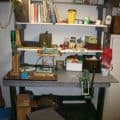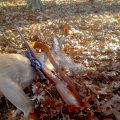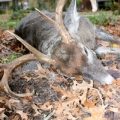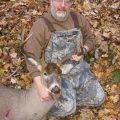The Shamanic Guide to Speed Scouting
I can remember this time back in 2001. I had just acquired a 200 acre farm. Season was only a few weeks away. I had seen a few deer and a few turkeys, but I frankly thought the numbers were going to be sparse. I was only able to get out there on weekends, so I spent the weekday nights studying maps and planning strategies. Let me tell you how I went about it and what I did wrong and what I have learned since.
First, get yourself a topo map and an aerial photo. Google Earth is pretty darn good for the latter. The former can be gotten via USAPhotoMaps. It’s a free GPS utility from JDMCox software. If you do not know how to read a topo, learn. Here is an online book: http://www.map-reading.com/
Here are three views of roughly the same area:
The first is a U.S.G.S. topo from USAPhotoMaps. It is just a random spot from an area near my place and contains a lot of the same kind of structures. The second pic is an aerial view from USAPhotoMaps. It is zoomed in a little on the farm that is in the middle of the topo. The third view is the same farm from Google Earth. You are welcome to download those images and play along.
Go over the topo and the aerial in minute detail. Look for any anomalies. Look for any structure, just like they tell you to with largemouth bass. Especially be concerned with the edges of things, the narrowing of things, how this relates to that, etc. Google has its good side and its bad. The good side is that it shows what’s really there. Second, it shows a history of various images. If there was a road back in 1994 and it is not there now, you can go find that road. It probably is being used by the deer. If there is cover in 2012 and there wasn’t any in 2001, that may be a cedar thicket that has just taken hold. The down side of Google Earth is that it does not show elevations well. If you get a topo map, it will show fairly subtle changes in elevation.
When you do get boots on the ground, concentrate on two things. Especially on smaller parcels, you need to circumnavigate the property and see where the deer are entering and leaving. When you get to the interior of the property, concentrate on the edges and corners of fields, narrowings, peninsulas and islands. This is where you are likely to find tracks and other sign and from there you can do more in-depth scouting later.
There were a bunch of things I looked for. Here are some examples:
Example 1:
I found several small erosion gullies along the sides of my ridges left over from 80 years ago when the hillsides were bare and the rain was washing down, carrying the hillside with it. Those became key features for me. The erosion gullies had superior oak trees on them, as well as a lack of undergrowth. It made for good clear shooting all up and down the gully, and a plentiful supply of acorns.
Example 2: There is about 40 acres of pasture on my property– open empty patches of grass. I could have spent all my time combing the 40 open acres, or the 160 forested acres, what I needed to concentrate on was the edge– where grass met woods. More specifically, I needed to look at those spots where the pasture narrowed, or ended in a point or that there was a peninsula of woods jutted out into the open field.
Example 3: My place is part of a ridge system, everything flowing eventually into the Licking River, about 2 miles away. It consists of some N/S and E/W finger ridges and finger-on-finger ridges with hollows between. One thing that stuck out was the few spots where dips in the elevation (saddles) made it easier for deer to go from one hollow to another. Additionally, I scouted the head and the mouth of each hollow
Example 4: My place is hilly, not too bad. There is less than 200 feet of elevation difference from the lowest to the highest. Most of this elevation is covered in only 100-200 yards in the steeper hillsides. Deer are lazy. If I could find the easiest way between one spot and another, I would probably find deer. That proved true in those hollows. Deer would enter at the bottom and work their way up to the top and invariably take the laziest path they could.
Example 5: The Topo could tell you where there was woods, but it was often times important to define exactly what type of woods. On Google Earth you can see a differentiation between hardwoods and cedar thickets, etc. Where cedar thicket met oak/hickory savannah? Those cedars ended up being a prime bedding area and the oaks were a buffet. It was like pulling into the cervid version of a Howard Johnson Motel with 31 flavors of ice cream and a clam dinner special right off the motel office.
Shelves are as rare as. . . well, they are rare in these parts. I found one on my property, and I found two small ones on the topo. You would never see them from Google Earth. There are a couple of places just near the bottom, left-of-middle, on the topo map where the contour lines widen out on the point or side of a ridge. That would be worth scouting. I ended up finding exactly 1 small shelf on my property. It was not all that flat, but it was enough to encourage a couple of large oak trees, and it had massive trails leading into it. I have seen more deer in a day from the stand I put there than any other stand or blind on the place.
There are a few saddles on the topo. Again, you would have a hard time picking them out from Google Earth. The key with saddles is to look along the top contour of a ridge. There will be pinches in the ridge at the head of each hollow. Look for two opposing pinches. These are often accompanied by little circular contours indicating rises in between the dip. Where two pinches oppose each other– that is where you want to focus your scouting.
On the weekends, I hiked incessantly. Most of it was looking for prints, trails, scat or other sign of deer. Once I found some sign, I tried to relate it to what I knew:
1) Where was the most likely source of food when these tracks were made?
2) Where was the most likely bedding area?
3) What was the easiest way to get from bed to food and back?
. . . and THAT is where you want your stand– in the best spot that gives you a good shot at deer moving along that trail.
Mind you, there were a lot of blind alleys. I ended up putting stands up at dead-nuts surefire spots and never once saw a deer. I put out salt in locations that next spring that never got touched. Still, it was a lot of those spots I picked out on my first few trips that ended up producing the most deer for me over the years.
Some tips I learned along the way:
1) Old tree stands are a dead giveaway. If you see a rotten piece of wood nailed up in a tree, there is a reason why it was put there. Remember that deer numbers were a lot lower a few decades ago and that deer will often times move along the same structures for 50 years or more without changing their habits. I have identified 2 generations of stands near some of mine. Somewhere in my weblog is a post about briar archeology: basically, if you find old beer cans next to a tree in the middle of the woods, you’ve got the makings of a good deer hunting spot.
2) Put out some buckets. Early on you may not want to commit your stands to a given area, but you want to check them out. Put out a bunch of overturned 5-gallon buckets in the places that look interesting and migrate from one bucket to the next during your first season or two. Sit a while and then move onto the next bucket.
3) Don’t think you’ve got the mother lode, just because you found a lot of sign. Deer are very dynamic animals. Their menu is constantly changing. Their habits are constantly changing. You may find a deer trail that looks like a hundred animals made it. In reality, it is 3-4 animals using it very intensively for a few weeks a year, but they’ve been doing it for generations. By season, it may be abandoned, and they have moved on to another food source or a new bed.
4) Don’t get too tied into anything. I spent my first season hitting this one stand in the evenings because I was SURE I was going to see deer– never did. The problem turned out to be that they were there, but by the time I was showing up, they were up on top of the hill, and I was down in the bottom.
5) Do not get all messed up if a deer busts you while you are out scouting. You did not tip the deer off to anything important. They will be back later in the week. I get busted when I am out hiking the property nearly every time I go out in the summer. The deer get used to it. They see me, the kids, the wife and the dogs as largely harmless.
The best window of time to be doing all this starts after season ends and runs until about the start of Turkey Season. The winter does not disturb much of the sign, and you can see what the deer are up to. Summer is a bum time, but sometimes it is all a guy gets. Everything works against you. The trails evident in winter are somewhat grown over. Sign like scat disappears quickly. The ground can be hard, and therefore hard to pick up prints. I was fairly convinced from my scouting that my new property had some deer and turkey, but not all that much. As it turned out, my deer and turkey take a hiatus from my ridges and go hang out in the bottoms for a few months starting in August. They come back about the time the acorns start dropping.
It’s funny, but there always this temptation to look for deer at the edge of the property. You see a trail coming from off your property and you’re sure there are 100 deer just over the line. You’ll think that way until you meet up with the neighbor, doing the same thing and coveting your property. It is a good idea to concentrate some of your speed scouting at making a good survey of the property line, but don’t get too tied to what you find. If you find trails at the fenceline, find out how they relate to what is on the interior of the property, and learn to hunt there. The grass is not all that greener– honest!
One last piece of info: If you are just getting started at this, and are a weekend hunter like me, do not think you will bag or even see The Big One your first season. In my case, I took two deer (one doe and one buck) off the new property in 2001. In 2002, I had a supremely bum season and only managed a 70 lb doe. It took until 2003 to nail a decent buck off the new place, and that one was my personal best for 25 years of trying. It took quite a bit of fine-tuning from that initial speed scouting in 2001 to get things dialed in, but I had the major bullet points nailed down in a couple of weekends.
This post has already been read 1624 times!
Views: 6











Comments
The Shamanic Guide to Speed Scouting — No Comments
HTML tags allowed in your comment: <a href="" title=""> <abbr title=""> <acronym title=""> <b> <blockquote cite=""> <cite> <code> <del datetime=""> <em> <i> <q cite=""> <s> <strike> <strong>